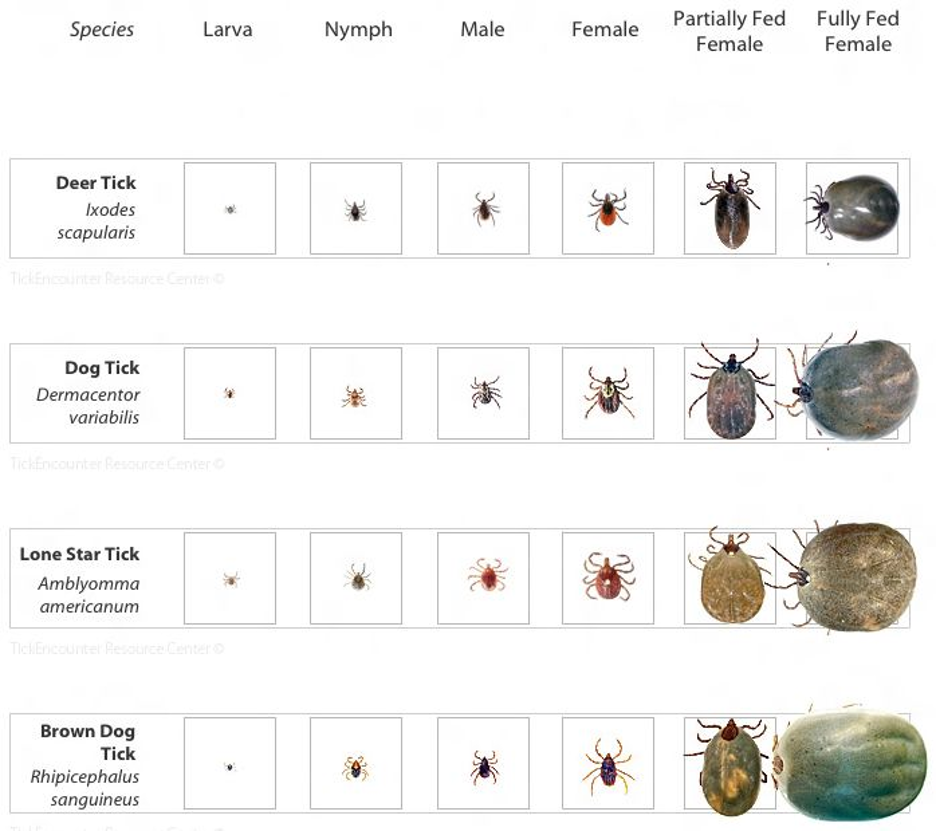Tick season is upon us! Actually, tick season is all year round. Deer ticks (the ticks responsible for transmitting Lyme disease) are not killed by freezing temperatures, and while other species of ticks ‘hibernate’, deer ticks will be active any winter day that the ground is not snow-covered or frozen, especially when temperatures hover just above freezing (0 – 4 degrees Celsius). Adult ticks prefer the late fall and well into December to quest for a meal, while immature ticks called nymphs (the size of poppy seeds) are actively seeking a blood meal in the early spring. Both of these life stages can spread Lyme disease. The prevalence of ticks and Lyme disease has been on the rise in Ontario. At least 15% of deer ticks carry Lyme disease, and the increasing number of ticks creates a higher risk for transmission.
For that reason we recommend year round tick prevention, especially in endemic regions such as Brighton.
You can check out Public Health Ontario’s Estimated Lyme Disease Risk Map for 2021 here: https://www.publichealthontario.ca/-/media/documents/o/2021/ontario-lyme-disease-risk-area-map-2021.pdf?la=en
Read through this information sheet for helpful facts on ticks and Lyme disease. Contact the clinic with any further questions.
Tick prevention tips for people:
- Wear light coloured clothing that covers legs and arms to allow ticks to be seen more easily and prevent access to your skin for attachment. Keep pant legs tucked into socks when possible.
- Don’t leave the beaten path – ticks are more commonly found in dense, brushy areas. They crawl up onto tall grasses and foliage to grab a hold of you when you brush past (unlike fleas, ticks don’t jump).
- Products containing DEET or Icaridin can deter ticks, so applying an insect repellent can help.
- Always check thoroughly for any ticks when you get home. Ticks are programmed to crawl to the head and ears, and like to find warm areas to embed themselves, so pay close attention to your scalp, armpits, groin, navel and behind your ears and knees.
- If you find a tick, remove it (see below) and contact your health care provider.
Tick prevention tips for pets:
- Use a recommended tick prevention product. It is best to consult with your veterinarian to determine the best product for your pet. There are both topical, and oral options. Common products include Advantix, Nexgard, and Bravecto.
- Stick to maintained pathways, and out of fields and dense underbrush.
- Check your pet thoroughly for ticks every day, paying extra attention to around the neck, head, and ears, although ticks have been found everywhere including between the toes.
- If you find a tick, remove it immediately.
Removing a tick:
- If you find a tick attached to yourself or your pet, it should be removed as soon as possible (this will decrease the risk of disease transmission).
- Fine-tipped tweezers work best, or approved tick removal tools such as ‘Tick Twisters’.
- Grasp the tick as close to the skin’s surface as possible, and pull upward with steady, even pressure (no jerking or twisting – this can cause the mouth parts to break off and remain in the skin). If the mouth parts break off and you are unable to remove them easily with clean tweezers then leave it alone for the skin to heal. Clean the bite area after removing the tick with soap and water or rubbing alcohol.
- Dispose of a live tick by flushing it down the sink/toilet, or placing it in a sealed container. NEVER CRUSH A TICK WITH YOUR FINGERS – THIS COULD EXPOSE YOU TO ANY DISEASE THE TICK MAY BE CARRYING.
- Avoid folklore and internet remedies recommending to cover the tick in any kind of substance or using heat (match) to make the tick detach. Anything that causes distress to the tick will cause it to regurgitate, which could lead to the transmission of Lyme or other diseases.
- Identification: Only the deer tick (black-legged tick) carries Lyme disease, so identification of the tick you removed is helpful to determine if Lyme disease is a risk. You can bring the tick (unsquashed and not dried out) to your veterinarian for identification, or it can be submitted to Dr. Weese and his team at the Ontario Veterinary College as part of their tick identification surveillance program free of charge (you just pay for shipping) by going to https://www.petsandticks.com/ and following the links to the tick tracker submission form: https://www.etick.ca/
*Note: Ticks submitted for identification will not be tested for disease, and ticks found on humans will not be accepted through this program*
Lyme Disease
- Lyme disease is a bacterial infection (Borrelia burgdorferi) transmitted through the bite of an infected deer tick (Ixodes Scapularis), also called the black-legged tick. (See the bottom of this article for a comment about Lyme disease from the Lone Star tick).
- A simple blood test (4DX) can screen your pet for exposure to Lyme and other tick transmitted diseases. It takes at approximately 3 – 5 weeks after a bite for a dog to test positive, so if you found a tick on your dog it’s best to schedule the bloodwork for approximately 6 weeks later.
- The risk for transmission of Lyme disease depends on how long an infected tick was attached:
< 24 hrs = very small risk
24 – 48 hrs = moderate risk
> 48 hrs = high risk
This highlights the importance of checking your pets – and yourself – for ticks daily, and removing any as soon as they are found.
- Symptoms of Lyme disease usually begin between three days to one month after being bitten by an infected tick, although the infection can lay dormant and not flare up until several months or years after exposure.
- The most common symptoms of Lyme disease in the dog are painful joints and lameness sometimes coupled with depression/lethargy, fever, and decreased appetite, which usually develops weeks to months after exposure. Less commonly, Lyme disease can attack the kidneys, and result in permanent damage to the kidneys that can be fatal.
- Vaccinations against Lyme disease are available, it is best to discuss the pros and cons of vaccination with your veterinarian.
- Luckily cats have not been found to be affected by Lyme disease, but we still want to prevent them from carrying ticks into the home with an appropriate prevention.
My dog tested positive for Lyme disease, now what??
- Most (> 90%) of dogs that test positive for Lyme disease on a 4DX blood test will NOT develop clinical symptoms. This is because most dogs can clear the infection with their immune system, although they will continue to test positive because of the presence of antibodies over the next several years. The test demonstrates the pet has been exposed to Lyme disease, but they may never become sick from it.
- If your dog tests positive for Lyme, but has no symptoms, we will want to make sure that the bacteria isn’t affecting your dogs kidneys, resulting in a serious condition called Lyme Nephritis. To do this, you will be asked to bring a first morning urine sample from your dog that we will check in clinic for the presence of protein. If positive for protein, then the urine will be sent to the lab for a test called a Urine Protein Creatinine Ratio, which will quantify how much protein is being lost, and will help us determine if we need to start treatment with antibiotics. Certain breeds such as Labs and Golden Retrievers are at a higher risk for developing this disease.
- If your dog tests positive for protein loss on the urine test, or is experiencing symptoms consistent with Lyme disease (lameness, lethargy, fever, inappetence), treatment with the antibiotic doxycycline for one month will be recommended.
- Treatment with antibiotics will only put the disease into ‘remission’. Lyme disease symptoms can flare up with further tick bites, so continued use of a tick prevention product is important.
Ontario tick species includes the Deer Tick/Black Legged Tick (Ixodes Scapularis), the American Dog Tick (Dermacentor variabilis) and the Brown Dog Tick (Rhipicephalus sanguineus). In Ontario, Lone Star ticks (Amblyomma Americanum) periodically appear. Experts have largely considered them adventitious, thinking they surfaced after hitching a ride on a migratory bird or mammal. But given the various reports, it appears the Lone Star tick is establishing a foothold here and may also be capable of transmitting Lyme disease via a different strain of Borrelia. Don’t fear – your pet’s tick prevention products are also effective against the Lone Star Tick.

Image saved from doverlyme.com
